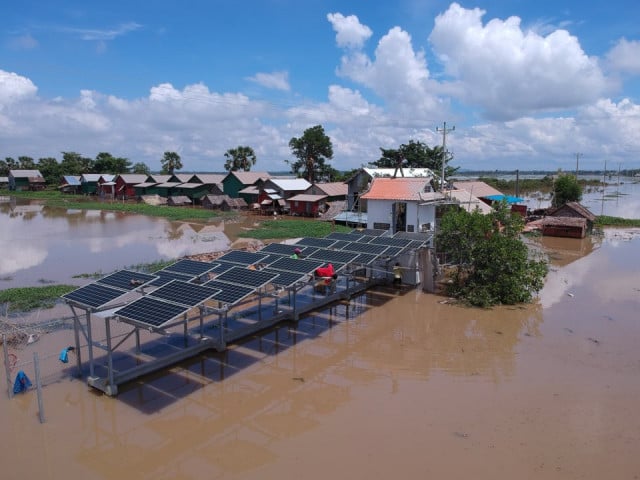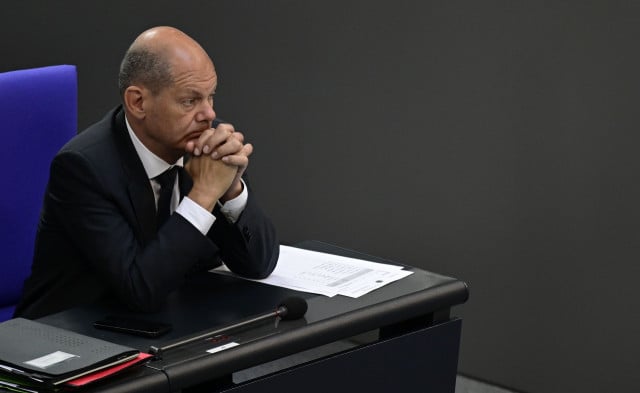Analysts Warn that Cambodia’s Lack of Renewable Energy Commitment May End up Affecting Foreign Investment in the Country

- Sao Phal Niseiy
- October 31, 2020 6:20 AM
Renewable energy sources are being looking into, a government spokesperson noted
PHNOMP PENH--Cambodia’s reliance on fossil fuel and particularly coal increasingly makes the country vulnerable to flights of capital as brand manufacturing companies protest the country’s lack of determination to expedite transition toward clean energy.
In a letter to Minister of Economy and Finance Aun Pornmoniroth on Aug. 13, six global brand manufacturing companies, which included the Swedish multinational clothing-retail company H&M, Puma SE, Adidas AG and Nike Inc., expressed their concern over Cambodia’s move to expand electricity capacity and production through coal.
H&M, which initiated the letter, said that Cambodia’s move to embrace coal power projects has been contrary to the global direction.
“While trends in many countries are prioritizing renewable energy in their national energy plans, we see a risk of Cambodia doing the opposite,” said Ulrika Isaksson, a press officer at the H&M Group, in an email response to Cambodianess.
“Any plans to add large amounts of coal-generated energy to the mix would however undermine this environmental position and have a negative impact on Cambodia as an important sourcing country,” she wrote.
In February 2020, Cambodia approved two new coal-fired power plants to be constructed in Koh Kong and in Oddar Meanchey provinces—which have been commissioned for operation by the end of 2021 and early 2022, respectively.
With a $1.6 billion capital investment the plants could generate up to 1,000 megawatts collectively. Han Seng Coal Mines will develop the power station in Oddar Meanchey Province, while Cambodian tycoon Kith Meng’s Royal Group will build the other in Koh Kong Province. Meng in Aug. 2020 was granted 168.8 hectares of the Botum Sakor National Park in Koh Kong Province for his power plant.
However, Victor Jona, a spokesperson for the Ministry of Mines and Energy, said that the current share of electricity from coal-fired plants is still small. “I want to inform [you] that the electricity generated by coal-fired power plants accounts for only less than 10 percent of the total electricity,” he said.
Responsibility to push for energy transition toward clean power
The campaigns to push the government to move away from coal power have been echoed by Cambodian environmentalists as well as energy experts as this will encourage the country to reconsider its current position on energy transition.
Han Phoumin, senior energy economist at the Economic Research Institute for ASEAN and East Asia, said that, currently, more brand companies are starting to monitor their supply chain—a move that manifests their corporate social responsibility of ensuring their products comply with social and environmental standards.
“To me, it is very good for global benefits as well as the benefit of the host countries,” Phoumin said in an email.
In this way, he continued, “it will make the country leaders, especially in developing countries like Cambodia, rethink their cleaner-energy system to attract more foreign investment.”
Ham Oudom, a consultant on natural resources management and water governance, agreed that, in addition to fulfilling environmental responsibility, the joint effort by brand manufacturing companies is also significant in emboldening a climate action.
“The action is catching up with the climate change response that has been jointly developed, especially by those who are bound by the United Nations Framework Convention on Climate Change, to keep the global temperature below 1.5 or not beyond 2 degrees by 2050,” said Oudam. “In this regard, Cambodia should be thankful to have such responsible investors.”
When there are globally and regionally prevailing energy-development options, he said, it is very questionable as a decision to still choose fossil fuel like coal—the most prominent contribution to global warming and threat to people’s wellbeing.
The risk of capital flight and environmental ramification
According to the Cambodia Basic Energy Plan prepared by the Ministry of Mines and Energy and the Economic Research Institute for ASEAN and East Asia, electricity demand is projected to grow by an annual average of 9 percent between 2015 and 2040.
In order to cope with the increase in demand, Cambodia will continue to rely on fossil fuel and coal as well as hydropower, putting the country in a very difficult situation when it comes to reinvigorating the energy transition toward clean energy to prevent capital flight and environmental catastrophe.
However, Jona dismissed the concern, stressing that Cambodia’s current energy tendency is already good and clean enough.
“I can say other countries also do the same. Because what we do is to ensure energy security and this needs an energy source diversification,” he said.
When asked whether the Cambodian government is ready to do more to increase share from renewable energy, Jona explained that the government has been expanding electricity share from solar and potential wind power.
“As decided by the government, up to 450 megawatts of electricity generated from solar system are to be integrated into the national grid by mid-2021, and we are also looking for other renewable energy sources such as wind power,” he said, pointing out that a 80-megawatt wind farm project is already under negotiation.
While the government side appeared to make light of the risks posed by fossil fuel and especially coal power, Oudam warned that sluggishness in altering the current energy trend will create both environmental and economic repercussions.
“If the Cambodian government holds on to its energy development plan—which is projected to generate 35 percent of total electricity from coal-fired and fossil fuel in general—the environmental and economic catastrophe is inevitable,” Oudam said.
Regarding economic consequences, he rationalized that, if the manufacturing companies really relocate their production base outside the country, hundreds of thousands of workers will be jobless.
“This is made even more serious since the partial withdrawal of the trade preferential “Everything But Arms” scheme by the European Union. This is going to create huge challenges for Cambodia’s economy,” he added.
As for the environmental aspect, the consequence will be even worse, Oudam continued, if any coal plants are constructed from old equipment that was already used, citing reports that revealed that one proposed coal-power plant would be built from parts of old retired facilities imported from China.
“I do not see much we can do to mitigate the forthcoming environmental and economic impacts,” Oudam stressed.
Phoumin, on the other hand, noted that the government perhaps understands the risk of having foreign investors moving away, suggesting that the new power development strategy 2020-2030 will offer new paths for further integrating renewable energy into the system.
“I think the government is aware of this issue [manufacturing companies’ relocation] and they will try to respond to it as they will not like to lose out on the foreign investment,” he said.
“The Power Development Plan (PDP) will likely address this concern. Thus, the new PDP 2020-2030 will see more share of gas combine cycle-power generations and more renewables such as solar to come in.”
As Cambodia is to rely on coal-fired power plants for many years to come, Phoumin suggested that they need to be modernized with the environmental facilities being equipped in order to ensure that the pollutants such as nitrogen oxides (NOx) and sulfur oxides (SOx) as well as carbon dioxide (CO2) are reduced to acceptable levels.
Manufacturing companies like H&M, however, have demonstrated a commitment to work hand in hand with the government in order to achieve a sustainable and effective energy transition, making sure that the country can safeguard its interests and circumvent potential loss from production relocation.
“We welcome an open and constructive dialogue with the Cambodian government on how to continue to develop the renewable energy landscape and decrease the dependency on fossil-base solutions for the supply chain,” said Isaksson of H&M.
“This will make it possible for companies and brands to take necessary steps toward their climate ambitions and consequently play a key role for Cambodia as an attractive sourcing country going forward,” she said,
Ways forward for Cambodia’s renewable energy
While energy experts agree that Cambodia should expedite the transition toward renewable energy, the government has repeatedly raised the issue of the unreliability of renewable energy sources, particularly solar power, and the ability to store electricity.
“It is widely known that solar can only be used five to six hours a day, so what kind of energy can we use during nighttime in case we don’t have enough?” Jona asked, adding that Cambodia still needs the other types of energy sources to guarantee this security.
In order to usher renewable energy transition and encourage more consumption, the energy experts have recommended that, from now on, the country’s leadership pay greater attention to policies aimed at promoting renewable energy.
“Affordable energy prices will require to have a deeper reform in the power sector including the privatization of all segments of the production, transmission and distribution networks,” Phoumin said.
“The power regulators will later on need to have sufficient rules and procedures to ensure market competition,” he added.
Recognizing that with the current power system, a higher share of renewable energy could be a problem for the grid stability, Phoumin said that it is imperative to upgrade the electricity infrastructure such as the grid.
“To do that, deeper reform will be needed in order to attract foreign investment and to boost efficiency by bringing in more efficient power generation and allowing gradual phasing out of the inefficient power plants,” he said.
Oudom, on the other hand, while acknowledging that there are technical and environmental issues in every technology, argued that the technical issues with solar energy, including storage batteries, are the main concerns of the government and are being steadily addressed.
“Globally, while the investment cost of coal is rising, the price of solar is declining,” he said, adding that it is quite discouraging that some important renewable-energy policies are still absent.
“[The] feed-in tariff, net metering and renewable portfolio standards, which have been successfully implemented in other countries and in particular Thailand, are not taken into account by the government,” Oudam added.















